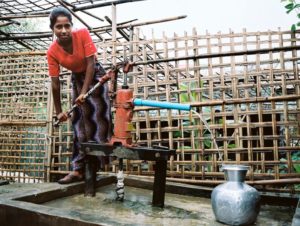Daily lives of Rohingya revealed in new photo exhibition
The dire living conditions of persecuted Rohingya in Western Myanmar have been revealed by an Australian photographer who visited internally displaced peoples’ camps in the region.
 In 2016, Alister McKeith (also known as Ali MC) travelled to camps in both Myanmar and Bangladesh at a considerable risk.
In 2016, Alister McKeith (also known as Ali MC) travelled to camps in both Myanmar and Bangladesh at a considerable risk.
In the Myanmar city of Sittwe, local government administration granted him limited access to the internally displaced person’ camps in the area, however he was arrested in Bangladesh and detained and questioned by the Bangladeshi Army.
Ali said the expedition was an attempt to photograph the Rohingya, who have become known as one of the world’s most persecuted people, document their living conditions at the camps and better understand the events that forced them into this situation.
“The Rohingya live in both Western Myanmar and Bangladesh, however they are not recognised as citizens of any country, and are forced into camps and isolated villages with strict restrictions placed on their daily lives,” Mr McKeith said.
 “These restrictions make it near impossible to travel, access education or seek medical assistance, nor can they partake in elements of public life, such as voting,” he said.
“These restrictions make it near impossible to travel, access education or seek medical assistance, nor can they partake in elements of public life, such as voting,” he said.
The Myanmar Government have long denied the existence of the Rohingya ethnic group, instead labelling them ‘Bengali’ due to their Bangladesh origins.
However one photo portrays a Rohingya man holding a copy of official documents confirming his family’s Rohingya identity.
Another shows a man selling medical supplies in the market.
Mr McKeith said conditions in the camp are dire, with electricity generated by donated solar panels and water pumped for communal wells, and entire families of up to 10 people are living in leaky one-room bamboo huts. One photo shows a Rohingya girl pumping water for her family.

Mr McKeith said the portraits in his new exhibition Rohinga: Refugee Crisis in Colour avoids the photojournalism of poverty and angst, rather the Rohinga are portrayed as a people with pride and determination.
“Despite their adverse living conditions, it is their strength and resilience that is captured on camera,” Mr McKeith said.
“The result is engaging, eye opening, and prompts viewers to further explore and understand the challenges facing Rohingya people,” he said.
Rohingya: Refugee Crisis in Colour is on exhibition in Fitzroy until Friday 26 May 2017. For more information click here.
Carissa Gilham
AMES Australia Staff Writer












